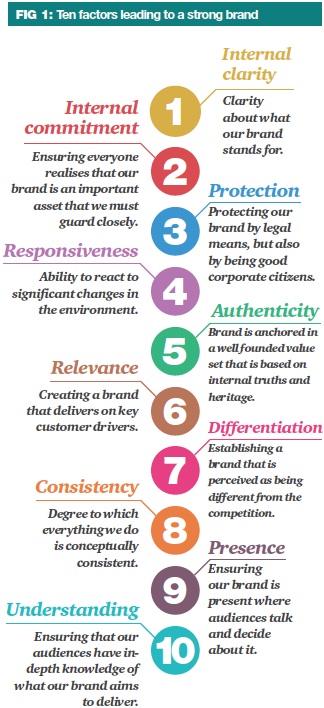The emergence of social media has enhanced our ability to communicate across long distances in an immediate manner. The repercussions of this advent upon the way organisations interact with their customers are undeniable. With every improvement in technology social media makes a significant amount of advantages are created for brands. Companies must also walk a thin line however, so as not to interfere with their existing branding strategy. In an interview with branding expert Patrick Stal, Managing Director of Interbrand Amsterdam, Tharawat magazine discovers just how organisations can use social media as a meaningful tool to further their branding and communications strategy.
How do the concepts of communication and branding interact with one another?
Some people make the mistake of thinking of branding as our identity but in reality it describes the way we do everything we do: The way we do business. The brand ensures that there is a consistent experience across all of our behaviours, whether those be defining products and services, or marketing communications. Communication is a part of branding, but it is by no means the only part, and for many businesses certainly not the most important.
The company brand must lie at the core of the organisation and communication one of the ways to bring the brand to life. More and more organisations are hiring chief brand officers onto their boards, reflecting the recognition that brand lies at the core of an organisation. A chief branding officer is different from a chief marketing officer: One ensures operational excellence in marketing communications, acts out the job of planning and delivering communications. The branding officer ensures that everything we do is in line with what we want to be doing as a brand – from product assortment to supply chain choices.
Has social media changed the way that we communicate?
Social media is the next evolution of technology that enables us to behave as social beings. In that sense, it hasn’t changed the way we communicate. It’s just made it easier to communicate. Our previous technology was limiting us. We had to plan communication. Now, if I have an idea, I can ping it to you. It’s almost like we’re in a constant conversation with one another. To some extent, we were doing that even as cavemen. We were sitting around the fire, we were sharing ideas. Social media has levelled the playing field, allowing us to communicate much more similar to the way we would communicate in physical life. The bigger question obviously is how social media has changed the way that we communicate as a business and as a brand.
In a recent conversation Thomas Marzano, digital design director at Phillip’s said to me that social media has done nothing other than take us back to how businesses were communicating a hundred years ago. I tend to agree with him. Let’s say that you were to open a shop a hundred years ago and would receive customers, inducing a lot of social interaction. You had a personal interaction and relationship with your customers and suppliers. In the 70s and 80s we all discovered the blessings of the first means of mass communication. We started using television, radio, and other media to further communicate with those shop customers. We discovered that there were ways to communicate our opinions to a wide-ranging audience. These means also created a distance and a flurry of one-directional communication. We were no longer talking with our customers, but at them. Today, the difference is that we’re not talking to one person on the other side of the counter, we are talking to tens of thousands of customers at a time. But social media has enabled us to have a real conversation and personal relationships with our customers again. It is very beneficial, if we use it correctly.
Do you believe that digital communication should be aimed at substituting personal communication?
There is no question about in my mind that social media is a slave of our human need for communication. I think it is a tool that we have developed to enable us to have the types of conversations that we would have if we were sitting next to one other. My personal opinion is that while many people may use social media to have those face-to-face conversations, nothing ever substitutes personal conversations. There’s research being done around whether social media limits the way that we interact as humans, and the effect it’s having on children. But I think at the core, it’s a technology that’s facilitating something that we already do as a people.
What do you think are the things that companies have to be most careful of when they use social media as a tool?
Let us first look at branding theory. There are a couple of points hat we know are statistically important to perform as a strong brand. There are ten factors:
- Internal clarity about what our brand stands for
- Internal commitment to brand. Ensuring everyone realises that our brand is an importance asset we must guard closely.
- Protection of our brand in a legal sense, but also by ensuring we are being a strong corporate citizen
- Responsiveness – our ability to react to significant changes in our environment
- Authenticity – ensuring the brand is anchored in a well founded value set that are based on internal truths and heritage
- Relevance – ensuring our brand delivers on key customer drivers
- Differentiation – the degree to which our brand is perceived as being distinctive from the competition
- Consistency – The degree to which everything we do is conceptually consistent
- Presence – Ensuring our brand is present where audiences talk about it, and decide about it
- Understanding – Ensuring that our audiences have an in-depth knowledge and understanding of what our brand aims to deliver
When looking at social media use we can start through the lens of relevance and authenticity: If a social media channel is not relevant to our product, our service, or our customers, then we shouldn’t feel obliged to use it as one of our communication tools. We should approach our decision to use social media based on our target audience. We have to ask ourselves whether this medium is relevant to what we’re trying to be as a brand.
The next point is authenticity: When you communicate through social media, the brand needs to make sure that what they communicate is really true in fact and true to our core. We’ve conditioned ourselves to understand that when brands speak to us on billboards and through television advertising, that those are commercial messages. We’ve created a place in our minds to place these messages. Imagine a personal conversation where we are speaking to a friend and that friend suddenly would start shouting that we needed to buy a specific product. We wouldn’t be very pleased. However, if that friend were to tell us in an informative way about something that he/she bought, that would pose a different narrative. It might even spark curiosity and more questions about the product. This explains the level of authenticity brands must utilise with social media if you are looking for a conversation.
What are the dangers and advantages in using social media internally?
If you can find social media that is customised for effective internal use then that’s going to help us and may bring people together. I think there’s no risk to that. The second situation to watch is how internal stakeholders interact with our customers directly through social media channels. A lot of brands are scared of this because of the lack of control. But if we have a business, we might have ten thousand employees. Let’s assume most of those people are happy to be working where they’re working. We can use this untapped resource to create brand ambassadors. Internal engagement has become much more important than it ever was. Ensuring that people in the business truly understand what your brand stands for, and what that means in the way that they operate on a daily basis becomes essential. We know that employees can make a positive branding contribution. I think that many of the companies that have started to dabble with social media five or six years ago are starting to get to the point of becoming more comfortable in opening up the tool to their entire workforce.
I think that the important thing here is that there is clarity internally around the brand. On a daily basis, employees could be having constructive, valuable conversations with your customer base. This might be worth a whole advertising campaign. I think turning people into brand ambassadors through internal brand engagement is the key for many businesses.
What are current trends in social media? How will this influence the communication strategies of companies in the future?
Back in the day, we all lived in the same village, and we saw each other every day; right now, our friends live across the globe, and so we have a need to interact with them and to keep track of them. That’s where social media comes in. Our world has grown; there’s a real need for LinkedIn and Facebook, for example. Social media will continue to enable us to do the things that we enjoy doing as social beings. In terms of the communication strategies, brands will shift their attention to how to advertise on social media and to internally invest. Firms will invest in their people enabling them to be powerful agents in what the company is trying to do as a business.
For family businesses, I think that there’s a huge potential there. Some of those businesses might be very afraid because it might open the family up to increased visibility. Traditionally, family business owners have kept themselves quite distant from the public eye so as to not put the family at reputational risk. I think that some businesses will continue to have this protective structure. I don’t think that it’s fair to judge your use of social media as a family business in the same way as other businesses. However, I think that you can open up the brand and the business, without necessarily exposing the family.
If families are actively branding themselves as a family business, explaining that they are better than competitors because they are family-owned, then they are purposely making themselves a large part of their brand. There is naturally a bigger role for these types of business owners to play in social media. They may want to have key family members that have separate Twitter accounts comment on some of the things that the brand is doing, and why that is right for the brand. I feel that many customers love that, because to them it’s just a sign of authenticity, displaying where the product or service comes from. The vision and story behind what the brand does. I think social media offers great tools to create those types of close customer relationships. We shouldn’t be afraid of it, because essentially, it’s just a translation of the way that we’ve always communicated.
Tharawat Magazine, Issue 17, 2013

















